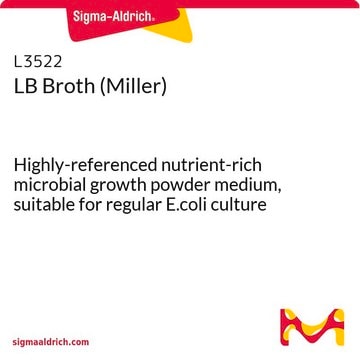N3643
NZCYM Broth
Powder microbial growth medium
Sinonimo/i:
Broth medium
About This Item
Prodotti consigliati
Grado
for molecular biology
Sterilità
non-sterile
Forma fisica
powder
Composizione
Casamino Acids, 1 g/L
MgSO4, 0.98 g/L
NaCL, 5 g/L
Tryptone, 10 g/L
Yeast extract, 5 g/L
tecniche
microbiological culture: suitable
pH
6.8-7.2(2.2% solution)
applicazioni
food and beverages
microbiology
Temperatura di conservazione
room temp
Compatibilità
nonselective for Escherichia coli
nonselective for coliforms
Descrizione generale
Applicazioni
Caratteristiche e vantaggi
- Standard formulation
- Convenient package sizes
- A budget-friendly alternative to liquid
Ricostituzione
Sostituito da
Codice della classe di stoccaggio
11 - Combustible Solids
Classe di pericolosità dell'acqua (WGK)
WGK 3
Punto d’infiammabilità (°F)
Not applicable
Punto d’infiammabilità (°C)
Not applicable
Dispositivi di protezione individuale
Eyeshields, Gloves, type N95 (US)
Certificati d'analisi (COA)
Cerca il Certificati d'analisi (COA) digitando il numero di lotto/batch corrispondente. I numeri di lotto o di batch sono stampati sull'etichetta dei prodotti dopo la parola ‘Lotto’ o ‘Batch’.
Possiedi già questo prodotto?
I documenti relativi ai prodotti acquistati recentemente sono disponibili nell’Archivio dei documenti.
I clienti hanno visto anche
Protocolli
General protocols for growth of competent cells in microbial medium.
Il team dei nostri ricercatori vanta grande esperienza in tutte le aree della ricerca quali Life Science, scienza dei materiali, sintesi chimica, cromatografia, discipline analitiche, ecc..
Contatta l'Assistenza Tecnica.











